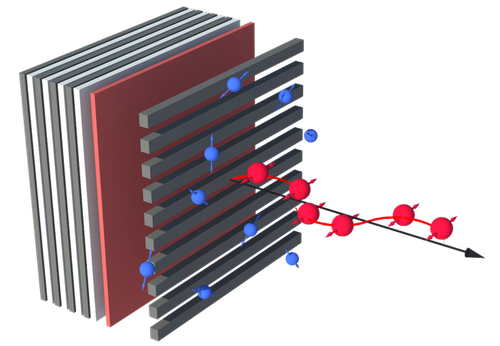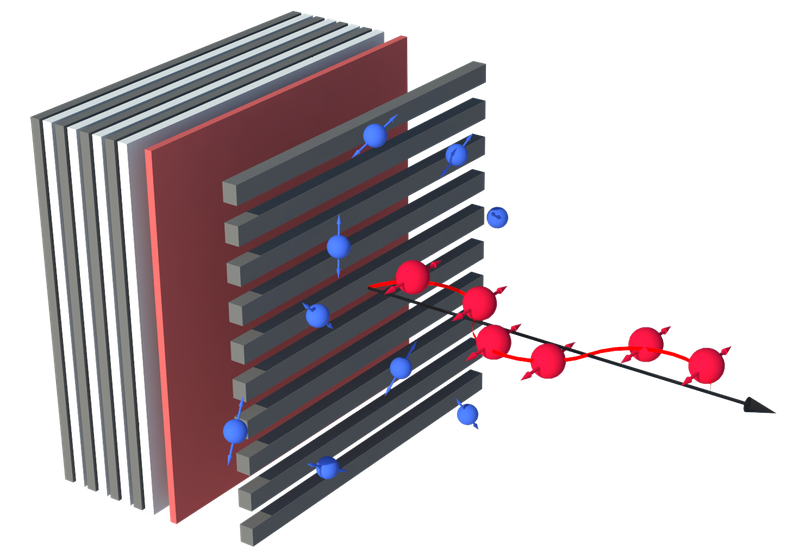Polariton Laser Upgrade
Polaritons are a combination of light and matter that can generate laser light with high efficiency, but the light's coherence—the quintessential property of laser light—is limited. New experiments on an unconventional polariton laser design now show that the coherence can be on par with traditional lasers. The researchers used two measures of coherence, one of which showed direct signs of polaritons interacting. The team imagines using these interactions to eventually tailor the laser emission for specific purposes, such as making a single photon source.
A polariton laser consists of a semiconductor material with mirrors at each end to make an optical cavity. When laser or electrical energy is pumped into the semiconductor, pairs of excited electrons and holes—called excitons—form and interact with photons confined to the cavity. The exciton-photon combination acts like a particle and is called a polariton. If the density of polaritons becomes high enough, their motion will be in-phase (or coherent), similar to the behavior of cold atoms in a Bose-Einstein condensate (BEC). As a result of this matter coherence, the light that leaks out of the cavity (due to a slight transparency in the mirrors) will also be in-phase, as from a traditional laser. But a polariton laser requires less than 1% of the input power of a laser based purely on photons (a photon laser), which makes polariton lasers potentially useful as optical switches in optical signal processing.
However, polariton lasers have inferior coherence properties compared with photon lasers, and coherence is essential for many potential uses, such as data transmission, says Hui Deng of the University of Michigan, Ann Arbor. Coherence is characterized by two related quantities: the coherence time (a measure of phase stablity) and the distribution of intensity fluctuations (a measure of intensity stability). High-quality photon lasers have long coherence times (microseconds) and intensity fluctuations at a statistical minimum called the Poisson limit. Current polariton lasers, by contrast, often have much shorter coherence times (picoseconds) and large intensity fluctuations that are at least 50 times the Poisson limit.
A few years ago Deng and her colleagues developed a polariton laser [1] that—like many previous designs—uses an external laser to generate excitons in semiconductor layers sandwiched between two mirrors. But in their device, one of these mirrors is a sub-wavelength grating (SWG), which is a series of bars etched in a thin dielectric layer. The small spacing of the bars (500 nanometers) combined with the dielectric's high index of refraction, makes the SWG highly reflective of light with wavelength greater than about 1 micrometer. Ordinarily there are two orientations or "modes" of the electric field oscillating in the optical cavity, and the SWG reflects one mode better than the other. This selectivity means that the cavity only supports one polariton mode, avoiding competition between modes that has contributed to the observed instability of other designs, Deng says.
To measure intensity fluctuations of their polariton laser at the level of photons, Deng and her colleagues used a common technique in which they split the beam in two and recorded the likelihood of simultaneously detecting photons in both beams. They found that the laser's photons were not “bunched” in time but arrived randomly, equivalent to reaching the Poisson limit, as expected for highly coherent light.
The researchers measured the coherence time with a standard technique and found it reached as high as 60 picoseconds. Increasing the input power caused the coherence time to first increase (as it does in photon lasers) but then suddenly drop. Previous theoretical work predicted this decay would occur as a result of polariton interactions. Using their coherence time data, Deng and her colleagues determined the strength of these interactions and found agreement with previous estimates based on different methods. Researchers hope to eventually use the polariton interactions to create single photon sources [2], which would be useful in quantum cryptography and quantum computing.
“This is an important advancement in the understanding of the polariton laser dynamics,” says Yoshihisa Yamamoto from Stanford University. He says the polariton community has had difficulty achieving coherent emission. Jonathan Keeling from the University of St. Andrews, UK, says that a key signature of polariton lasers—the decay in the coherence time—has finally been observed after much experimental effort. “This paper represents a culmination of this work, showing that when all experimental variables are controlled for, the theoretical pictures are indeed right."
This research is published in Physical Review X.
–Michael Schirber
Michael Schirber is a Corresponding Editor for Physics Magazine based in Lyon, France.
References
- B. Zhang, Z. Wang, S. Brodbeck, C. Schneider, M. Kamp, S. Höfling, H. Deng, “Zero-Dimensional Polariton Laser in a Subwavelength Grating-Based Vertical Microcavity,” Light: Sci. Appl. 3, e135 (2014).
- A. Verger, C. Ciuti, and I. Carusotto, “Polariton Quantum Blockade in a Photonic Dot,” Phys. Rev. B 73, 193306 (2006).





